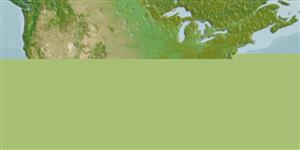Environment: milieu / climate zone / depth range / distribution range
Ecologia
marino; salmastro demersale; distribuzione batimetrica 1 - 43 m (Ref. 89891). Subtropical; 37°N - 9°N, 98°W - 59°W
Western Atlantic: Virginia to Texas in USA, northern Mexico, south to Trinidad and Tobago.
Size / Peso / Age
Maturity: Lm ? range ? - 35 cm
Max length : 83.0 cm TL maschio/sesso non determinato; (Ref. 40637); common length : 50.0 cm TL maschio/sesso non determinato; (Ref. 3275); peso massimo pubblicato: 9.3 kg (Ref. 4699); Età massima riportata: 8 anni (Ref. 46275)
A cryptic species that tolerates low salinities; occurs frequently in brackish bays and estuaries, even on occasion in fresh water (Ref. 9988). Minimum depth is at 0.7 meters (Ref. 128969). Adults are found mostly over mud bottoms in estuaries and coastal waters to about 40 m depth. Taken by anglers inshore from bridges, jetties and small boats. They move to deeper water in winter, but are still easily accessible (Ref. 9988). Adults feed chiefly on fishes, also on crabs and shrimps. Juveniles take mainly small bottom-living invertebrates. Marketed fresh and frozen; eaten steamed, fried, boiled, microwaved and baked (Ref. 9988).
Distinct pairing (Ref. 205).
Robins, C.R. and G.C. Ray, 1986. A field guide to Atlantic coast fishes of North America. Houghton Mifflin Company, Boston, U.S.A. 354 p. (Ref. 7251)
IUCN Red List Status (Ref. 130435)
Threat to humans
Harmless
Human uses
Pesca: commerciale; Pesce da pesca sportiva: si
Strumenti
Special reports
Download XML
Fonti Internet
Estimates based on models
Preferred temperature (Ref.
123201): 23.2 - 24.9, mean 23.9 °C (based on 168 cells).
Phylogenetic diversity index (Ref.
82804): PD
50 = 0.5000 [Uniqueness, from 0.5 = low to 2.0 = high].
Bayesian length-weight: a=0.00575 (0.00365 - 0.00908), b=3.19 (3.06 - 3.32), in cm total length, based on LWR estimates for this species & Genus-body shape (Ref.
93245).
Trophic level (Ref.
69278): 3.5 ±0.48 se; based on food items.
Resilienza (Ref.
120179): Medio, tempo minimo di raddoppiamento della popolazione 1.4 - 4.4 anni (K=0.21-0.23; tmax=8).
Fishing Vulnerability (Ref.
59153): Moderate vulnerability (44 of 100).
Nutrients (Ref.
124155): Calcium = 59.8 [28.1, 127.9] mg/100g; Iron = 0.832 [0.414, 1.467] mg/100g; Protein = 16.8 [14.4, 20.0] %; Omega3 = 0.177 [0.092, 0.329] g/100g; Selenium = 27.5 [13.9, 60.6] μg/100g; VitaminA = 5.32 [1.60, 17.66] μg/100g; Zinc = 0.618 [0.423, 0.918] mg/100g (wet weight);
